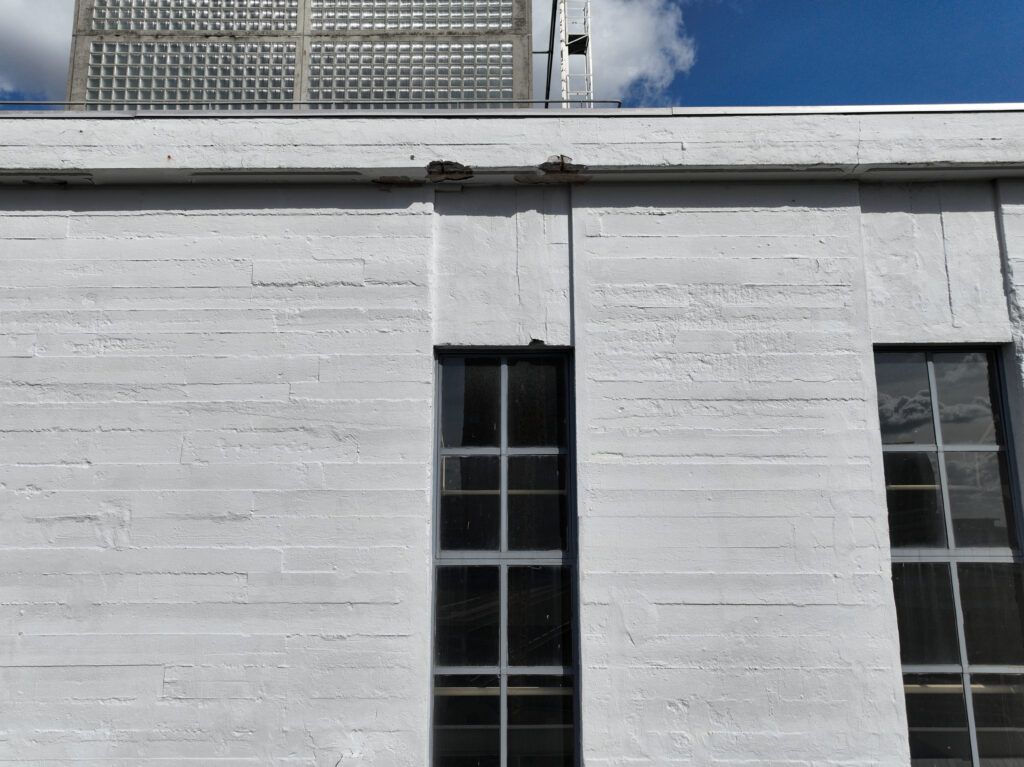Virtual facade inspection of the Klokgebouw in Eindhoven
The Klokgebouw was built in 1928. This famous building has a rich history and is representative of almost a century of architectural heritage. This means that the building has been standing for almost 100 years. Constructions are designed to last a long time. For concrete this is between 50 and 100 years. To keep the Klokgebouw attractive and maintained, it is necessary to extend the lifespan of the building and therefore to carry out maintenance. It has also emerged that concrete parts are falling from the roof edge. This is very dangerous! The risk of falling debris means that a thorough inspection and repair is urgent. Enough reasons to make a complete overview of the building.
Traditional inspection methods
A traditional way to inspect is to be physically present at a part that needs to be inspected. Since the Klokgebouw does not have the ideal shape and height to accommodate the ladder, other ways are needed to carry out the inspection. This can be done, for example, with a crane and an inspector in the man box. This allows difficult corners to be reached. While these methods can be effective, they are not always practical or cost-efficient, especially for large, complex buildings such as the Clock Building.
Innovative inspection using drones
In the context of technology and optimization, there are other ways to carry out the inspection. Advances in drone technology and digital image processing now make inspections much more efficient and smarter. We believe that the inspection of the roof edge of the Klokgebouw can be done “smarter” and cheaper. We used the drone for this. We can take pictures of the building with drones. These recordings can then be converted into a 3D model. This is done using the photogrammetry technique. This can then be used to carry out analyzes and (digital) inspections. As a product, a satellite photo has been generated of the current situation. The following (major) advantages can be mentioned:
- Efficient: this innovative inspection is ready within one working day. Compared to the “traditional” methods, this is a major time saving when it comes to man hours. You also save on costs such as equipment.
- Insightful: visual inspections through drone recording ensure that the most important features of defects become visible. The drone takes high-resolution images and this makes it possible to detect even the smallest cracks and defects. This is very important for early intervention.
- Data-oriented: making recordings and sharing them with others. As a result, there is only one truth in the provision of information. This ensures that all parties involved can communicate more easily and decisions can be made more efficiently.
- Flexible: there is no need to make an appointment with the resident or user, because the inspection takes place outside - without entering the building. The residents are very happy with this.
Result
The flight took a total of 3 hours. We were able to take more than 1,000 photos of all facade surfaces. A 3D model has been generated from these photos using advanced technology. This model is not only photorealistic, but also serves as a basis for the virtual inspection. Thanks to this virtual model we can examine the building in detail without being physically present!
The virtual model has shown that repairs have already been carried out on the facade several times. This indicates that there were maintenance issues for an extended period of time. For a building that is almost 100 years old, this can be explained logically. There have also been a number of worrying findings revealed by the innovative inspection. It has become apparent that the roof edge is not level, an indication that (concrete) pieces have fallen down or are about to fall. These findings are recorded in a so-called inspection report and handed over to the client.

Conclusion
Working with the drone has not only led to better and more insightful results for the Klokgebouw, but has also contributed to reducing the risks in the context of safety for the inspectors. We implemented a plan that avoided heavy equipment, fall protection, and climbing. The safety of employees is always of paramount importance and the use of a drone is therefore a logical choice. Because we believe that safety is an important topic, we will delve deeper into this topic in a later blog.
We are pleased that we have successfully applied this new approach to the iconic Klokgebouw. We look forward to future projects where we can use this innovative technology more often.
Are you inspired by our story and do you have a similar case? Then take Contact with us!
Client: Trudo
Main contractor: Van Asperdt
Advisor: NLbeton Inspections BV
NOTAM: M0730_23
Operation in the Specific category and permission from Eindhoven Airport.

